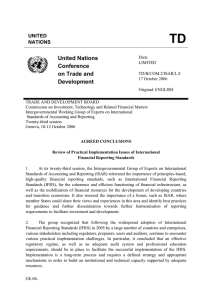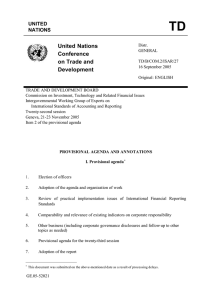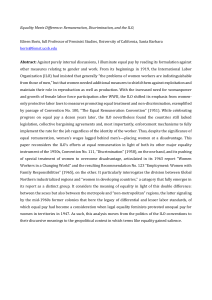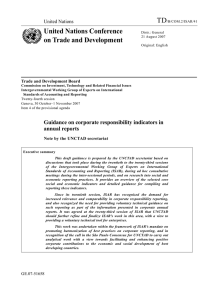TD United Nations Conference on Trade and
advertisement
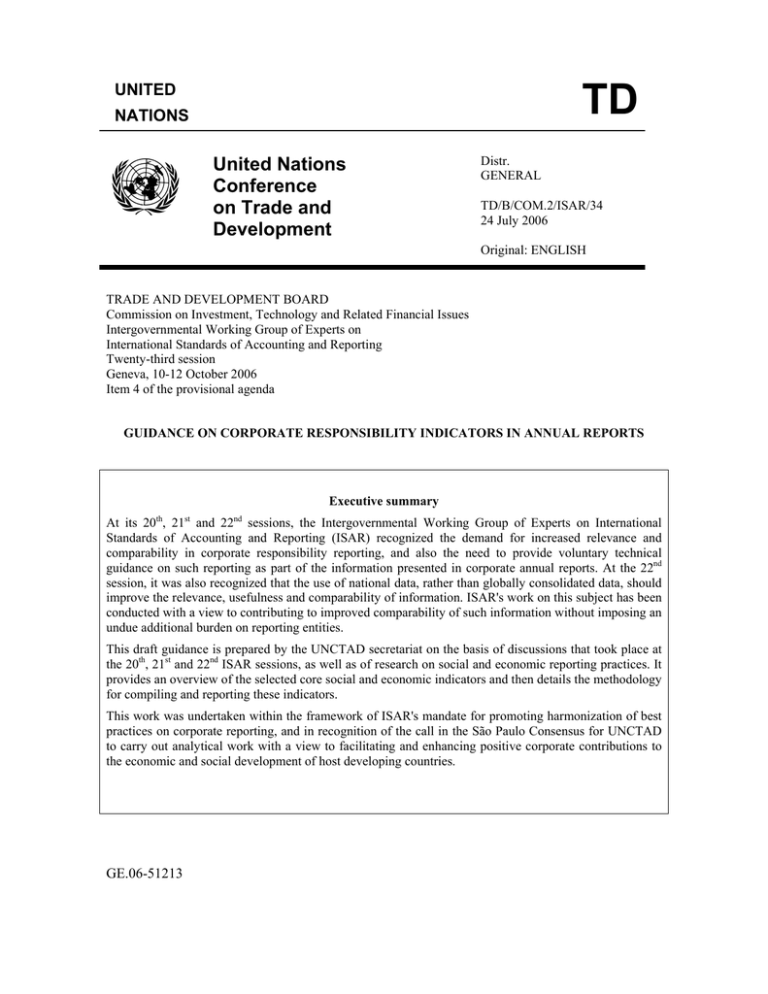
TD UNITED NATIONS United Nations Conference on Trade and Development Distr. GENERAL TD/B/COM.2/ISAR/34 24 July 2006 Original: ENGLISH TRADE AND DEVELOPMENT BOARD Commission on Investment, Technology and Related Financial Issues Intergovernmental Working Group of Experts on International Standards of Accounting and Reporting Twenty-third session Geneva, 10-12 October 2006 Item 4 of the provisional agenda GUIDANCE ON CORPORATE RESPONSIBILITY INDICATORS IN ANNUAL REPORTS Executive summary th st nd At its 20 , 21 and 22 sessions, the Intergovernmental Working Group of Experts on International Standards of Accounting and Reporting (ISAR) recognized the demand for increased relevance and comparability in corporate responsibility reporting, and also the need to provide voluntary technical guidance on such reporting as part of the information presented in corporate annual reports. At the 22nd session, it was also recognized that the use of national data, rather than globally consolidated data, should improve the relevance, usefulness and comparability of information. ISAR's work on this subject has been conducted with a view to contributing to improved comparability of such information without imposing an undue additional burden on reporting entities. This draft guidance is prepared by the UNCTAD secretariat on the basis of discussions that took place at the 20th, 21st and 22nd ISAR sessions, as well as of research on social and economic reporting practices. It provides an overview of the selected core social and economic indicators and then details the methodology for compiling and reporting these indicators. This work was undertaken within the framework of ISAR's mandate for promoting harmonization of best practices on corporate reporting, and in recognition of the call in the São Paulo Consensus for UNCTAD to carry out analytical work with a view to facilitating and enhancing positive corporate contributions to the economic and social development of host developing countries. GE.06-51213 TD/B/COM.2/ISAR/34 Page 2 Contents Page Introduction 3 I. Overview of selected indicators 4 II. Review of measurement methodology for selected indicators 5 A. Contribution to economic development 6 B. Human rights 9 C. Labour practices 10 D. Human resource development 11 E. Health and safety 13 F. Community support 15 G. Value chain 15 H. Corruption 16 III. 17 Conclusion Annex I. Classification of employee function 18 Annex II. References 21 Annex III. Eco-efficiency indicators 23 TD/B/COM.2/ISAR/34 Page 3 INTRODUCTION 1. In the São Paulo Consensus of UNCTAD XI, member States recognized that UNCTAD should "assist developing countries, in particular LDCs, to design and implement active policies for building productive capacity and international competitiveness based on an integrated treatment of investment, corporate responsibility, technology transfer and innovation, enterprise development and business facilitation (including transportation and information and communication technology), competitiveness, diversification and export capacity, to sustain a high level of growth and promote sustainable development" (TD/410, para. 49). 2. Since its 18th session, the Intergovernmental Working Group of Experts on International Standards of Accounting and Reporting (ISAR) has viewed reporting on corporate responsibility as one of the emerging issues in the area of corporate transparency. ISAR recognized at its 20th session that more enterprises are producing reports and that the quality and the quantity of these reports continue to improve, and that peer and public pressure for further improving reporting on social issues was increasing. It was further noted that various groups and initiatives had begun to do a tremendous amount of work in this area. ISAR concluded, however, that the satisfaction of some stakeholders with the quality and comparability of such reports remained low and that the increasing demand for information in the area of corporate responsibility was imposing a growing burden on enterprises as they tried to respond to various stakeholders. 3. The 21st session of ISAR began to examine existing indicators so that corporate reports could be made more relevant and comparable. It noted that UNCTAD XI had provided a broader context in which the issue of corporate responsibility could be addressed, including an economic development dimension.1 In particular, ISAR agreed that "such information could also reflect corporate contributions to the economic and social development of host countries, as well as the need for capacity building" (TD/B/COM.2/ISAR/26). 4. At its 22nd session, the Group of Experts suggested that follow-up work on measurement methodology for selected indicators could be conducted to ensure consistent reporting on these issues. The objective of this report is to provide detailed work on measurement methodology with a view to refining and finalizing ISAR's guidance on voluntary disclosures in this subject area. The report builds on earlier reports prepared by the secretariat for the 20th, 21st and 22nd sessions of ISAR. In particular, it develops measurement methodology for the 17 indicators (see table 1) identified during the 22nd session in paper TD/B/COM.2/ISAR/29 (ISAR/29) and it is recommended that the two reports be read together. ISAR/29 explored in detail the selection criteria for the indicators discussed below; the criteria were made up of quality criteria, guiding principles and constraints. The four quality criteria were: 5. i. Comparability; ii. Relevance and materiality; iii. Understandability; iv. Reliability and verifiability. 6. The five guiding principles were: i. Universality to maximize comparability; 1 The first intergovernmental meeting on this subject was held by UNCTAD from 31 October to 2 November 2. See the document "Positive Corporate Contributions to the Economic and Social Development of Host Developing Countries" (TD/B/COM.2/EM17/2). TD/B/COM.2/ISAR/34 Page 4 ii. Incremental approach; iii. Capable of consistent measurement; iv. Impact-oriented rather than process-oriented; v. Link to sustainable development. 7. And the three constraints in selecting core topics and indicators were: i. Costs and benefits; ii. Confidentiality; iii. Timeliness. It was recognized at the 22nd session of ISAR that these selection criteria, while necessary for producing relevant and comparable reports, may also exclude some otherwise useful topics such as technology transfer or country-specific social issues. Therefore, it has been the position of ISAR that enterprises are encouraged to provide additional useful information beyond the selected core indicators. The Group of Experts also recognized that users of social reporting would need to consider the broader industrial and national context of a reporting enterprise when interpreting the data in its reports. 8. 9. While environmental issues are also recognized as an important feature of corporate responsibility, this report does not focus on environmental issues, as ISAR has previously conducted extensive work in this area. In 1989 ISAR took up the topic of corporate environmental accounting. In the following years several recommendations were published in this area: the 1999 report Accounting and Financial Reporting for Environmental Costs and Liabilities (UNCTAD/ITE/EDS/4); the 2000 report Integrating Environmental and Financial Performance at the Enterprise Level (UNCTAD/ITE/TED/1); and the 2004 manual Eco-Efficiency Indicators (UNCTAD/ITE/IPC/2003/7). The five eco-efficiency indicators identified in the 2004 manual are listed in annex III. 10. The present report is divided into two main sections and a conclusion. The first section provides a concise overview of the selected indicators in the form of a table. The second section provides detailed guidance on compiling each of the selected indicators and is organized around the following main points: i. Compilation: how to calculate and report the indicator; ii. Definitions: any specific terms that require clarification; iii. Documentation: the sources of data needed to compile the report. 11. Some indicators detailed below require a breakdown of the reporting enterprise's workforce by employment category. In order to ensure comparability in these cases, it is suggested that reporting enterprises could use the definition of "major group" of employment category set out in the International Labour OrganiZation's guidance, "International Standard Classification of Occupations". This can be found in annex I at the end of this document. References to additional guidance or international standards that could usefully be consulted in compiling each indicator are noted in annex II. I. OVERVIEW OF SELECTED INDICATORS 12. The table below provides an overview of the selected indicators identified in document TD/B/COM.2/ISAR/29. Table 1. Selected indicators TD/B/COM.2/ISAR/34 Page 5 Group Sub-group Contribution to Economic Development Indicator 1. Total sales 2. Value of imports vs exports 3. Total workforce 4. Employee wages and benefits 5. Payments to government 6. Labour productivity Human Rights Labour Practices Security 7. Number of enterprise operations with armed security Equal Opportunity 8. Number of female employees and ratio of male to female wages and benefits Workforce Turnover 9. Total number and rate of employee turnover Collective Bargaining 10. Percentage of employees covered by collective bargaining agreements Human Resource Development 11. Average hours of training Health and Safety 13. Expenditure on employee health and safety 12. Expenditure on employee training 14. Work days lost due to accidents, injuries and illness Community Support 15. Voluntary contributions to civil society Value Chain 16. Number of dependent enterprises in the value chain Corruption 17. Number of convictions for violations of corruptionrelated laws or regulations and amount of fines paid/payable II. REVIEW OF MEASUREMENT METHODOLOGY FOR SELECTED INDICATORS 13. To ensure consistent reporting of the selected indicators, a measurement methodology is described for each of the indicators in the sections below. To better reflect corporate contributions to social and economic development within host countries, the measurement methodology for each indicator is intended to be used to compile relevant data for the national reports of an enterprise, rather than consolidated global reports. The use of global reporting provides an important macro view of a TNC's operations; however, most indicators that reflect corporate contributions to economic and social development are primarily relevant in a national context. TD/B/COM.2/ISAR/34 Page 6 14. As noted in TD/B/COM.2/ISAR/29, the selected indicators are drawn from a range of existing reporting principles, initiatives and standards, including financial reporting principles, the practices of specific enterprises, government reporting standards and the Global Reporting Initiative. Consequently, due care has been taken to use the same methodology as other organizations where the same indicator has been used.2 For some indicators, slight adaptations of existing methodologies have been made in order to ensure a focus on national reporting. A. Contribution to economic development 1. Total sales 15. The total sales of an enterprise allows for an approximate calculation of the enterprise’s contribution to GDP and its overall economic impact on the economy in which it operates. This indicator should reflect gross sales.3 16. Compilation Gross sales from products and services. 17. Definitions None. 18. Documentation Finance, treasury or accounting departments should have the information that this indicator requires. 2. Value of imports vs exports 19. The value of an enterprise’s exports in relation to its imports, as an indicator of the contribution of an enterprise to the balance of payments of the country in which it operates, could also give information about the economic contribution of an enterprise to that country's economy; this issue is of particular relevance for developing countries which must manage their "hard currency" reserves. 20. Compilation The compilation of this indicator is based on generally accepted financial accounting principles: a. Identify all the transactions of the reporting company concerning its current, capital and financial account with economic units from a country where the company is not resident. b. Identify whether these transactions are exports or imports from the perspective of the reporting company. c. Calculate the contribution of the reporting company to the host country's balance of payments (CCBP) using the following formula: CCBP = ∑ Export - ∑ Import. 21. Transactions refer to: a. Current account: goods; services; income; current transfers; b. Capital and financial account: i. Capital transfers; acquisition or disposal of non-produced, non-financial assets; ii. Financial assets and liabilities. 2 In the case of GRI indicators, the methodology referenced is based on the draft G3 technical protocols, as the final G3 technical protocols were still in production at the time of writing. 3 It was recognized in TD/B/COM.2/ISAR/29 that calculation of enterprise value added may also be an appropriate indicator for gauging an enterprise's overall economic impact on the economy in which it operates. TD/B/COM.2/ISAR/34 Page 7 22. Definitions a. Economic territory: Economic territory may not be identical with boundaries recognized for political purposes. A country’s economic territory consists of a geographical territory administered by a Government; within this geographical territory, persons, goods and capital circulate freely. For maritime countries, geographical territory includes any islands subject to the same fiscal and monetary authorities as the mainland. b. Residence of enterprises: An enterprise is said to have a centre of economic interest and to be a resident unit of a country (economic territory) when it is engaged in a significant amount of production of goods and/or services there or when it owns land or buildings located there. The enterprise must maintain at least one production establishment (goods and/or services) in the country and must plan to operate the establishment indefinitely or over a long period of time. 23. Documentation Finance, treasury or accounting departments should have the information that this indicator requires. 3. Total workforce 24. One of the most significant positive economic contributions an enterprise can make to the country in which it operates comes through the creation of jobs. When reporting the number of employees, the enterprise should provide a breakdown by employment type (full-time or part-time) and by major employment category. 25. Compilation a. When collecting data on the workforce, assess the full-time/part-time status of workforce members on the basis of definitions under the national laws of the country where they are based. Independent contractors and workers in the supply chain are not included in this indicator. b. State the number of individuals in the organization’s employ at the end of the reporting period, with a breakdown by employment type (full-time or part-time) and by major employment category. c. State the number of expatriates (non-nationals) employed by the reporting organization, with a breakdown by employment type (full-time or part-time) and by major employment category. d. If applicable, describe any significant seasonal variations in employment numbers (e.g. in the tourism or agricultural industries). 26. Definitions of employment types a. Employee: person with a direct employment relationship with the reporting enterprise, as recognized by national law. b. Full-time employment: a "full-time employee" is defined according to national legislation and practice regarding working time. The definition is often in terms of months per year or hours per week employed. c. Part-time: a "part-time employee" is an employee whose working hours per week, or months per year, are less than "full-time" as defined above. 27. Documentation Payroll information should provide data for this indicator. 4. Employee wages and benefits 28. The creation of jobs and the payment of wages and other benefits to employees represent one of the most important positive economic impacts of an enterprise. The total payroll of an enterprise, through the multiplier effect, supports the economic activity and economic development of the community in which the employees live. This indicator should reflect the total monetary outgoings on the employee workforce during the reporting period. In order to better gauge the contribution to poverty reduction, the TD/B/COM.2/ISAR/34 Page 8 indicator should also include a breakdown by major employment category and by employment type (parttime/full-time). 29. Compilation a. State the total annual payroll of the reporting organization. Provide a breakdown of the total annual payroll by each major group of employment category across the organization’s operations at the end of the reporting year. Provide a breakdown of the total annual payroll by employment type (part-time/full-time; see indicator 3 above). b. State the total annual benefits of the reporting organization, together with a breakdown of the total annual benefits by each major group of employment category across the organization’s operations at the end of the reporting year. Provide a breakdown of the total annual benefits by employment type (part-time/full-time; see indicator 3 above). 30. Definitions a. Total annual payroll: total of all employee salaries, including amounts paid to government institutions (employee taxes, levies and unemployment funds) on behalf of employees, paid within a calendar year. Non-employees working in an operational role should not be included within payroll but under Operating Costs as a service purchased. b. Total annual benefits: total of all regular contributions, (e.g. to pensions, insurance, company vehicles, private health), as well as other employee support such as housing, interest-free loans, public transport assistance, educational grants and redundancy payments, paid within a calendar year. This does not include training, costs of protective equipment or other cost items directly related to the employee’s job function. 31. Documentation Finance, treasury or accounting departments should have the information that this indicator requires. 5. Payments to government 32. Enterprises make a significant economic contribution to government finances in the form of taxes, royalties and other fees paid to Governments. This is particularly important for industries that do not have large payrolls or strong business linkages, and whose principal contribution to economic development is in the form of taxes.4 33. Compilation All company taxes (corporate, income, property, etc.) and related penalties paid at the national and local levels. Taxes included should be on a cash paid basis. This figure should not include deferred taxes because they may not be paid. 34. Definitions None. 35. Documentation Finance, treasury or accounting departments should have the information that this indicator requires. 6. Labour productivity 36. Enterprises often contribute to increases in labour productivity. This is especially true of TNCs that transfer knowledge and technology and invest in human resource formation. A measurement of an individual enterprise's labour productivity becomes an indicator of the enterprise's contribution to the overall economic efficiency and competitiveness of the country in which the enterprise operates. 4 For example,this issue is the subject of the Extractive Industry Transparency Initiative, a effort led by the UK Government and involving key enterprises in the extractive industry. It is also the subject of the "Publish What You Pay" campaign, which involves more than 300 civil society groups around the world. TD/B/COM.2/ISAR/34 Page 9 37. Compilation Labour productivity, based on gross output Quantity index of gross output Labour productivity = Quantity index of labour input 38. Price indices to deflate current-price series of inputs and outputs play a major role in productivity measurement. It is, for example, important that price statistics on inputs be generated independently from price series for outputs. Input-based indicators that are used to deflate output series generate an obvious bias in productivity measures. Occurrences of such input-based extrapolation are concentrated in activities where market output prices are difficult to observe. Difficult-to-measure industries include increasingly important activities such as banking, insurance and distribution. 39. Definitions a. Gross output: goods or services that are produced within a producer unit and that become available for use outside the unit. This is a gross measure in the sense that it represents the value of sales and net additions to inventories without, however, allowing for purchases of intermediate inputs. b. Labour input: labour input is most appropriately measured as the total number of hours worked. Simple headcounts of employed persons will hide changes in average hours worked, caused by the evolution of part-time work or the effect of variations in overtime, absence from work or shifts in normal hours. 40. Documentation Finance, treasury or accounting departments and the human resource department should have the information that this indicator requires. B. Human rights 7. Number of enterprise operations with armed security 41. One of the most basic human rights is the right to life, liberty and security of person.5 The United Nations Global Compact emphasizes that enterprises should avoid complicity in human rights abuses. Where such complicity has arisen in the past, it has often been associated with an enterprise's security arrangements and human rights abuses committed against members of a local community. Enterprises have a legitimate need to provide security for their personnel and equipment. In many situations this includes a need for armed security personnel. However, when armed security personnel are not properly trained and supervised this can become a human rights risk for an enterprise's surrounding community, as well as a reputation risk and potential legal liability for an enterprise. The first step in identifying such risks is identification of the locations where armed security is deployed, together with an indication of what type of security arrangements have been made. 42. Compilation a. Identify the total number of enterprise locations (number of distinct operating sites within a country) that employ armed security personnel. When reporting this number, indicate whether the armed security personnel employed are direct employees or contractors, or both. b. If the use of armed security contractors is reported, the enterprise should further indicate whether the contractor is either a private enterprise or a government force. Examples of government forces that contract armed security include local police and national militaries. 5 Article 3 of the Universal Declaration of Human Rights (www.un.org/rights). TD/B/COM.2/ISAR/34 Page 10 c. The reporting enterprise should also indicate whether (i) enterprises are required by law to contract armed security, and (ii) whether enterprises are required by law to contract armed security from government forces. 43. Definitions a. Armed security: a person who carries or has immediate access to a firearm in the performance of his or her duties, and who is employed to safeguard and protect persons and property or prevent theft, loss or concealment of any tangible or intangible personal property on the premises hired to protect. b. Contractor: a person who directly supplies work and services to the reporting organization but whose formal contract of employment is with another organization. 44. Documentation A potential information source is the records of the reporting organization’s human resources department or procurement department. C. Labour practices 8. Number of female employees and ratio of male to female wages and benefits 45. An enterprise's contribution to eliminating discrimination is a central feature of corporate responsibility. The extent to which an enterprise reduces discrimination can also be considered a measure of the management team’s ability to recruit and retain people on the basis of merit. Given the guiding principles for selecting indicators, and in particular the universality principle, the selected indicator focuses on the issue of gender discrimination. 46. Compilation a. State the total number of employees at year-end broken down by gender and major employment group. b. Calculate the average annual wage and average annual benefits for each major employment group with a break-down by gender. State the ratio of average annual wages for males to females; and state the ratio of average annual benefits for males to females. Refer to indicator 4 above for calculation of wages and benefits. 47. Definitions None. 48. Documentation A potential information source is the reporting organization’s human resources department. 9. Total number and rate of employee turnover 49. Workforce turnover rates serve to reflect the job security of employees, and the employment practices of an enterprise. Important issues can be initially reflected in an enterprise's turnover statistics, which can be compared with industry averages or best practice within the enterprise's industry, or even other industries. 50. Compilation a. Identify the total number of employees leaving employment during the reporting period. b. State the absolute number and rate of employees leaving employment during the reporting period, broken down by gender and by age groups (e.g.<30; 30-50; >50). c. Rates should be calculated using the total employee numbers at the end of the reporting period. 51. Definitions a. Turnover: number of employees who leave the organization voluntarily or because of dismissal, retirement or death in service. TD/B/COM.2/ISAR/34 Page 11 52. Documentation Potential sources of information, which include payroll information available at national or site level, should provide data for this purpose; also, operational plans and restatements of the organization’s key strategic targets may provide reasons for large variations in these figures. 10. Percentage of employees covered by collective bargaining agreements 53. Employees have the internationally recognized rights to establish and join organizations of their own choosing, and to have representative organizations for the purpose of collective bargaining. Whether or not employees exercise these rights in practice varies by location, industry and enterprise. For those stakeholders who are trying to assess the relationship between management and workers, it is helpful to know how many employees are covered by collective bargaining agreements. 54. Compilation a. Use data from indicator number 3 above (total workforce) as the basis for calculating percentages for this indicator. b. This indicator refers to collective bargaining agreements signed by the reporting organization itself or by employer organizations of which it is a member. These agreements can be at the sector, national or regional level. c. Identify the number of employees covered by collective bargaining agreements. d. State the number of employees covered as a percentage of the total number of employees. 55. Definitions None. 56. Documentation Records of formal recognition agreements and signed collective agreements with independent trade unions will normally be held by the Human Resources/Personnel Department of the reporting organization, or in the office of the reporting organization's legal counsel. In cases of doubt about the independent nature of an individual trade union body, and in the absence of data to determine its independence according to the ILO criteria given above, the International Confederation of Free Trade Unions (ICFTU) is normally able to provide guidance (see www.icftu.org). D. Human resource development 57. One of the ways in which companies can best contribute to local communities is to enable employees to develop their skills. Training local employees leaves them in a stronger position to obtain new employment or start their own businesses. In economic terms, training of employees represents the management’s conscious effort to invest in its human resources. This training can be measured in two ways: by average hours of training per employee and by expenditure on training per employee. 11. Average hours of training per year per employee broken down by employee category 58. Compilation a. Identify the number of employees for each major group of employment category across the organization’s operations at the end of the reporting year. b. Identify total hours devoted to training personnel within each major group of employment category. c. State the number of hours of training per year per employee by category of employee using the following formula: Total hours per category Number of hours of training per year per category = Total employees per category TD/B/COM.2/ISAR/34 Page 12 59. Definitions a. Training: All types of vocational training and instruction; paid educational leave provided by the reporting organization for its employees; training or education pursued externally and paid for in whole or in part by the reporting organization; and training on specific topics such as health and safety. It does not include on-site coaching by supervisors. b. Employment category: Major groups of employees as defined by the International Labour Organization's International Standard Classification of Occupations (see annex I). 60. Documentation Potential sources of information include employee records and training schedules. 12. Expenditure on employee training per year per employee, broken down by employee category 61. Compilation a. Identify exact figures on training costs from the sources, which are known in the enterprise (accounts, data files, minutes etc.). b. Identify estimates of the training costs only if these data are not available. c. Calculate the expenditures using the formula below and state the resulting figure per employee with a break-down by each major group of employment category across the organization’s operations at the end of the reporting year. Expenditure on employee training = Direct costs of training + indirect costs of training d. Direct costs: ∑ Costs described under definitions (a) to (f) below – ∑ receipts described under definition (g) below. e. Indirect costs: ∑ [(Hourly labour costs + hourly potential output) * hours of training] 62. Definitions Costs of external and internal vocational training courses: a. Fees and payments (to vocational training providers and external trainers). This refers to the total amount paid in fees for external courses or for external trainers or instructors (including those providing internal courses). It includes also payments made to external consultants, assessors or examiners for course-related activities. Any payments made by employers for courses that have been undertaken in employees' own time are included. Fees for training courses undertaken by apprentices or trainees are excluded. Fees and payments for learning material for open and distance courses, wherever possible, are excluded. b. Travel and subsistence payments. This refers to actual payments made to cover the travel and subsistence costs of employees participating in vocational training courses. It includes also any additional payments made for time spent travelling to courses. c. Labour costs of internal trainers exclusively involved in managing and delivering vocational training courses. d. Labour cost of internal trainers, partly involved in managing and delivering vocational training courses. The staff engaged in designing, managing, conducting or supporting vocational training courses comprise: i. Internal trainers and staff of training centres; ii. Directors and other managers concerned with training policy; iii. Instructors and training managers or officers; TD/B/COM.2/ISAR/34 Page 13 iv. Clerical/administrative and other personnel supporting these activities; v. Anyone dealing solely with apprenticeship training and anyone who is not a member of the normal workforce of the enterprise are excluded. For staff engaged full-time in courserelated activities, the figures quoted should be the total annual labour costs of all those identified. For staff engaged part-time in course-related activities, it should be a proportion of their labour costs, reflecting the proportion of time they spent on course-related activities. e. Costs of premises. These costs include: i. The cost of running a training centre (excluding staff labour costs) or any other premises used for vocational training courses; ii. Equipment or materials bought specifically for vocational training courses; iii. If the training centre or other premises or equipment are used only partly for vocational training courses, (e.g. if used also for training of apprentices) a proportion of the total cost should be included, representing the proportion of time they are used for vocational training courses. f. Contributions to collective funding arrangements; g. Receipts for vocational training courses. Receipts from collective funds, that is grants for vocational training courses, and from sources of revenue for vocational training courses such as the following: receipts from regional/sector funds; receipts from national funds; subsidies from EU sources; government subsidies; government rebates on expenditures; tax concessions on expenditures; external financial assistance from non-government sources, such as private foundations; royalty payments from external bodies and persons for the use of training resources developed by the enterprise; and receipts for vocational training courses provided to external bodies and persons. 63. Documentation Finance, treasury or accounting departments or the human resource department should have the information that this indicator requires. E. Health and safety 13. Expenditure on employee health and safety 64. Employee health and safety is one of the most important corporate responsibility issues confronting organizations. This is particularly true for companies operating in an environment with weak regulatory infrastructure. Poor employee health and safety records can undermine the social and economic development of a community. Occupational accidents can also negatively impact on enterprise development by lowering employee productivity, undermining human resource development and diverting management attention; underperformance in this area can be symptomatic of poor management. 65. Compilation a. Identify company expenditure on occupational safety and health related insurance programmes. b. Identify company expenditure on health care activities financed directly by the company, either through self-insurance or in operating-company-owned health care facilities. c. Identify company expenditure on working environment issues related to occupational safety and health (see "Employee safety" under definitions below). d. Calculate total company expenditures on employee health and safety by adding up the figures obtained in identification steps (a) through (c). State the resulting figure per employee, with a break-down by each major group of employment category across the organization’s operations at the end of the reporting year. TD/B/COM.2/ISAR/34 Page 14 66. Definitions a. Employee safety: occupational safety, occupational health and working environment are related to the following fields (ILO R164, II, 3): design, siting, structural features, installation, maintenance, repair and alteration of workplaces and means of access thereto and egress therefrom; lighting, ventilation, order and cleanliness of workplaces; temperature, humidity and movement of air in the workplace; design, construction, use, maintenance, testing and inspection of machinery and equipment liable to present hazards and, as appropriate, their approval and transfer; prevention of harmful physical or mental stress due to conditions of work; handling, stacking and storage of loads and materials, manually or mechanically; use of electricity; manufacture, packing, labelling, transport, storage and use of dangerous substances and agents, disposal of their wastes and residues, and, as appropriate, their replacement by other substances or agents which are not dangerous or which are less dangerous; radiation protection; prevention and control of, and protection against, occupational hazards due to noise and vibration; control of the atmosphere and other ambient factors in workplaces; prevention and control of hazards due to high and low barometric pressures; prevention of fires and explosions and measures to be taken in the event of fire or explosion; design, manufacture, supply, use, maintenance and testing of personal protective equipment and protective clothing; sanitary installations, washing facilities, facilities for changing and storing clothes, supply of drinking water, and any other welfare facilities connected with occupational safety and health; first-aid treatment; establishment of emergency plans; supervision of the health of workers. 67. Documentation Finance, treasury or accounting departments and the human resource department should have the information that this indicator requires. 14. Work days lost due to accidents, injuries and illness 68. Compilation a. This indicator should provide a breakdown according to: i. The total workforce (i.e. total employees, plus supervised contract workers); and ii. Independent contractors working on site in respect of whom the reporting organization assumes liability for the general safety of the working environment. b. Data on "lost days" should be based on the definitions under the national law of the country in which the "lost day"' occurred. In calculalting "lost days" it should be noted: (i) whether "days" means "calendar days" or "scheduled work days"; and (ii) at what point the "lost days" count begins (e.g. the day after the accident or three days after the accident). c. State lost day rate (LDR) by calculating as follows: LDR = 69. No. of lost days Total scheduled workforce working hours Definitions a. Injury: A non-fatal or fatal injury arising out of or in the course of work. b. Occupational disease: A disease arising from the work situation or activity (e.g. stress or regular exposure to harmful chemicals), or from a work-related injury. c. Lost day: Time ("days") which could not be worked (and is thus "lost") as a consequence of an employee being unable to perform his or her usual work because of an occupational accident or disease. Specific national definitions for the purpose of calculating "lost days" exist in the national labour laws of most countries. TD/B/COM.2/ISAR/34 Page 15 d. Lost day rate: Refers to the impact of occupational accidents and diseases, as reflected in time off work taken by the affected workers. It is expressed by comparing the total lost days against the total number of hours scheduled to be worked by the workforce in the reporting period. 70. Documentation Employee records, employee contracts, attendance records and accident records will provide relevant data for this indicator. F. Community support 15. Voluntary contributions to civil society 71. Many enterprises support the communities in which they operate through a variety of voluntary contributions, including the donation of cash, goods and services, and support for employee volunteerism schemes. These direct contributions can result in significant positive contributions to, for example, the sustainable development of local infrastructure such as schools and hospitals, as well as the provision of emergency relief in times of natural disaster. This indicator focuses specifically on an enterprise's voluntary contributions and investment of funds in the wider community, including donations. 72. Compilation a. Voluntary donations and investment of funds in the wider community where the target beneficiaries are external to the company.6 These include contributions to charities, NGOs and research institutes (not related to the company’s commercial R&D), funds to support community infrastructure (e.g. recreational facilities) and direct costs of social programmes (including arts and educational events). The amount included should account for actual expenditures in the reporting period, not commitments. b. For infrastructure investments, the calculation of the total investment should include costs for goods and labour in addition to capital costs. For support of ongoing facilities or programmes (e.g. an organization funds the daily operations of a public facility), the reported investment should include operating costs. c. This excludes legal and commercial activities or where the purpose of the investment is exclusively commercial. d. Any infrastructure investment which is primarily driven by core business needs (e.g. building a road to a mine or factory), or is for the purpose of facilitating the business operations of the organization, should not be included. The calculation of investment may include infrastructure built outside the main business activities of the reporting organization, such as a school, or a hospital for employees and their families. 73. Definitions None. 74. Documentation Financial records will provide relevant data for this indicator. G. Value chain 16. Number of dependent enterprises in the value chain 75. Since enterprises are able to influence only those members of their value chain which are in some way dependent upon the enterprise, the interpretation of corporate responsibility indicators related to suppliers and distributors begins with some understanding of the number of dependent suppliers and distributors within an enterprise's value chain. 6 "External to the company" means that the recipients are non-related third parties, i.e. legally separate entities of the company. It does not mean that the funds donated cannot be used by third parties, at their discretion, to benefit the reporting enterprise's employees or family members of its employees. TD/B/COM.2/ISAR/34 Page 16 76. The economic dependence of enterprises in a value chain is necessarily a matter of degrees of dependence, rather than a particular threshold. Therefore, this indicator is reported in three categories or ranges of dependence from 100% to >70% to >40%. 77. Compilation a. Identify only those members of the value chain (suppliers and distributors) that have had an ongoing business relationship of at least 24 months or more with the reporting enterprise. b. Calculate the value of business with each member of the value chain (value of purchases from suppliers, value of sales to distributors). c. Calculate (as a percentage) the dependence of each member of the value chain in the following way: i. Suppliers: Dependence = Total value of purchases from supplier Total sales of supplier ii. Distributors: Dependence = Total value of sales to the distributor Total value of purchases by the distributor iii. List the number of dependent enterprises in the value chain, with a breakdown by suppliers and distributors, country of location and degree of dependence. The degree of dependence should be noted using the following three categories: 100% dependence; 70%-99% dependence; and 40%-69% dependence. 78. Definitions None 79. Documentation Purchasing and sales departments should have the information that this indicator requires. Additional information will be required from suppliers and distributors. H. Corruption 17. Number of convictions for violations of corruption-related laws or regulations and amount of fines paid/payable 80. Corruption is internationally recognized as an obstacle to economic development and a hindrance to international trade and investment. Corporations can make a positive contribution to respect for anticorruption laws and international norms by ensuring that they are not involved in corruption. A basic measurable performance indicator in this regard is the number of legal infractions that a company incurs as a result of corrupt practices. This indicator can provide useful information to stakeholders about legal liabilities and areas of the enterprise's internal control that require attention. 81. Compilation a. Identify all convictions for violations of corruption-related laws or regulations. b. Identify the amount of fines paid/payable. c. State the reference number of the convictions and the amount of fines. 82. Definitions a. Corruption: the OECD defines corruption as the “active or passive misuse of the powers of Public officials (appointed or elected) for private financial or other benefits”. b. Bribery: the offering, promising, giving or accepting of any undue pecuniary or other advantage to or by a public official at national, local or international level, a political party, party official or TD/B/COM.2/ISAR/34 Page 17 candidate, or a director, officer, employee or agent of a private enterprise; in order to obtain or retain a business or other improper advantage, for example, in connection with regulatory permits, taxation, customs and judicial and legislative proceedings. c. Extortion or solicitation: the demanding of a bribe, whether or not coupled with a threat if the demand is refused. “Bribery” as used in these rules shall include extortion. 83. Documentation Records within an enterprise's legal department or financial accounting department should provide the necessary information for compiling this indicator. III. CONCLUSION 84. In accordance with the agreed conclusions of the 22nd session of the Group of Experts, the UNCTAD secretariat is presenting for consideration by the 23rd session of ISAR this detailed work on measurement methodology with a view to finalizing ISAR's guidance on voluntary disclosures in this subject area. On the basis of this work, ISAR may choose to carry out further work on the feasibility of this document as a tool for improving the comparability and relevance of corporate responsibility reporting in annual reports. Such further work could include conducting surveys on corporate disclosures on these issues, using this document as a benchmark. TD/B/COM.2/ISAR/34 Page 18 ANNEX I. CLASSIFICATION OF EMPLOYEE FUNCTION7 MAJOR GROUP ISCO CODE SUB-MAJOR GROUP8 NOTES9 1: LEGISLATORS, SENIOR OFFICIALS AND MANAGERS 1210 Directors and Chief Executives This group is intended to include persons who − as directors or chief executives − manage enterprises or organizations with 10 or more employees. 1220 Production and Operations Department Managers This group is intended to include persons who indicate a production and/or operational managerial specialism in enterprises or organizations with 10 or more employees. 1230 Other Department Managers This group should be restricted to persons who indicate a non-production/non-operational managerial specialism in enterprises or organizations with 10 or more employees. 13 Managers of small enterprises This group is intended to include persons who manage small enterprises, or organizations with 0-9 employees, on their own behalf, or on behalf of the proprietor, and may have some non-managerial help. Non-managerial staff should be classified according to their specific tasks. 21 Physical, mathematical and engineering science professionals This sub-major group includes occupations whose main tasks require a high level of professional experience in the physical, mathematical and engineering sciences (ILO, 1990; p .47). 22 Life science and health professionals Life science and health professionals conduct research, improve or develop concepts, theories and operational methods, or apply scientific knowledge relating to fields such as biology, zoology, botany, ecology, physiology, biochemistry, microbiology, pharmacology, agronomy and medicine (ILO, 1990; p. 59). 23 Teaching professionals Teaching professionals teach the theory and practice of one or more disciplines at different educational levels, conduct research and improve or develop concepts, theories and operational methods pertaining to their particular discipline, and prepare scholarly papers and books (ILO 1990; p. 65). 24 Other professionals Other professionals conduct research, concepts, theories and operational knowledge relating to information organization of business, as well as psychology, politics, economics, languages, sociology, other social entertainment (ILO, 1990; p. 72). 2: PROFESSIONALS improve or develop methods, or apply dissemination and to philosophy, law, history, religion, sciences, arts and Depending upon the specific tasks and degree of responsibility, as well as on the national educational and 7 Derived from the International Labour Organization (ILO) International Standard Classification of Occupations (ISCO-88) 8 This proposal contains all of the 28 sub-major groups of ISCO88 except sub-major group “11 Legislators and senior officials”, as employees of this group are not expected to work in private enterprises. 9 Source: Peter Elias and Margaret Birch: “Establishment of Community-Wide Occupational Statistics ISCO 88 (COM) A Guide for Users”, http://www.warwick.ac.uk/ier/isco/isco88.pdf. TD/B/COM.2/ISAR/34 Page 19 training requirements, it may be appropriate to classify some of the occupations identified here into sub-major group 34 (Other associate professionals) (ILO, 1990; p. 72). 3: TECHNICIANS AND ASSOCIATE PROFESSIONALS 4: CLERKS Technicians and associate professionals perform mostly technical and related tasks connected with research and the application of scientific and artistic concepts and operational methods, and government or business regulations, and teach at certain educational levels. 31 Physical and engineering science associate professionals 32 Life science and health associate professionals 33 Teaching associate professionals See notes for sub-major group 23 (Teaching professionals). 34 Other associate professionals Other associate professionals perform technical tasks connected with the practical application of knowledge relating to finance and sales, business enterprise administration, bookkeeping, legal, statistical and other services, government activities relating to customs, travel, tax, welfare, job placement, licensing, the police force, as well as with social work, entertainment, sport and religion (ILO, 1990; p. 113). 41 Office clerks Clerks record, store, compute and retrieve information, perform a number of clerical duties especially in connection with money-handling operations, travel arrangements, requests for information and appointments 42 Customer services clerks Customer services clerks deal directly with clients in connections with money-handling operations, travel arrangements, requests for information, appointments and by operating telehone switchboards (ILO, 1990; p. 139). Allocation of clerks between sub-major groups 41 (Office clerks) and 42 (Customer services clerks) will be performed with reference to job titles and/or job descriptions. Specific job titles/descriptions which indicate direct customer service interaction (e.g. counter clerk, receptionist, telephonist) will result in classification within sub-major group 42 (Customer services clerks). 5: SERVICE WORKERS AND SHOP AND MARKET SALES 51 Personal and protective services workers Service workers and shop and market sales workers provide personal and protective services related to travel, housekeeping, personal care, or protection against fire, unlawful acts, or they pose as models for artistic creation and display, or demonstrate and sell goods in wholesale or retail shops and similar establishments, as well as at stalls and on markets. 52 Models, salespersons and demonstrators See definitional notes to major group 5 (Service Workers and Shop and Market Sales Workers) 61 Skilled agricultural and fishery workers Sub-major group 61 (Skilled agricultural and fishery workers) consists of those occupations which require skills at the second ISCO skill level (education which begins at the age of 14 or 15 and lasts about three years – a period of on-the-job training may be necessary, which may supplement or replace the formal education) (ILO, 1990; p. 157 & 3). WORKERS 6: SKILLED AGRICULTURAL AND FISHERY WORKERS TD/B/COM.2/ISAR/34 Page 20 7: CRAFT AND RELATED TRADES WORKERS 8: PLANT AND MACHINE OPERATORS AND ASSEMBLERS 71 Extraction and building trades workers 72 Metal, machinery and related trades workers 73 Precision, handicraft, craft printing and related trades workers 74 Other craft and related trades workers 81 Stationary plant and related operators Craft and related trades workers apply their specific knowledge and skills to produce or process goods. The tasks call for an understanding of all stages of the production process, the materials and tools used and the nature and purpose of the final product. Most occupations in this group require skills at the second ISCO level (ILO, 1990; p. 173) Plant and machine operators and assemblers operate and monitor industrial and agricultural machinery and equipment on the spot or by remote control, drive and operate trains, motor vehicles and mobile machinery and equipment, or assemble products from component parts according to strict specifications and procedures. The work mainly calls for experience with, and an understanding of, industrial and agricultural machinery and equipment as well as an ability to cope with machine-paced operations and to adapt to technological innovations. "Stationary plant" should be interpreted primarily as "process plant". 9: ELEMENTARY OCCUPATIONS 82 Machine operators and assemblers 83 Drivers and mobile plant operators 91 Sales and services elementary occupations 92 Agricultural, fishery and related labourers 93 Labourers in mining, construction, manufacturing and transport Elementary occupations consist mainly of simple and routine tasks which mainly require the use of hand-held tools and often some physical effort. TD/B/COM.2/ISAR/34 Page 21 ANNEX II. REFERENCES 1. Total Sales: Applicable accounting standards, such as International Accounting Standard (IAS) 18 on Revenues, could be consulted. 2. Value of imports vs exports: balance of payments manual of the International Monetary Fund; European Balance of Payments/International Investment Position Statistical Methods. 3. Total workforce: ILO International Classification of Status in Employment; ILO Key Indicators of the Labour Market; ILO Laborstat Internet Indicators. 4. Employee wages and benefits: Applicable accounting standards, such as International Accounting Standard (IAS) 19 on Employee Benefits, could be consulted. 5. Payments to government: Applicable accounting standards, such as International Accounting Standard (IAS) 12 on Income Taxes, IAS 7 on Cash Flow statements and IAS 19 on Employee Benefits, could be consulted. 6. Labour productivity: ILO Key Indicators of the Labour Market (KILM 18. Labour productivity and unit labour costs); OECD Manual on Measuring Productivity. 7. Number of enterprise operations with armed security: Commentary on the Norms on the Responsibilities of Transnational Corporations and Other Business Enterprises with Regard to Human Rights U.N. Doc. E/CN.4/Sub.2/2003/38/Rev.2 (2003) Section C Right to security of persons, para 4. 8. Number of female employees and ratio of male to female wages and benefits: OECD Guidelines for Multinational Enterprises, Chapter IV Employment and Industrial Relations, Article d); ILO C111 Discrimination (Employment and Occupation) Convention (1958), Article 1. 9. Percentage of employees covered by collective bargaining agreements: ILO Convention 87, "Freedom of Association and Protection of the Right to Organise", 1948; ILO Convention 98, "Right to Organise and Collective Bargaining", 1949; ILO Convention 135, "Workers" Representatives Convention", 1971; ILO Convention 154, "Collective Bargaining Convention", 1981 and Recommendations 91, "Collective Agreements Recommendation" 1951, and 163, "Collective Bargaining Recommendation", 1981; ILO Declaration on Fundamental Principles and Rights at Work, 86th Session, 1998, Article 2 (a); OECD Guidelines for Multinational Enterprises, Section IV, Paragraph 2 (a). 10. Average hours of training per year per employee broken down by employee category: ILO International Standard Classification of Occupations (ISCO-88); ILO Convention 142, "Human Resources Development Convention", 1975; ILO Convention 140, "Paid Educational Leave Convention", 1974; ILO Convention 155, "Occupational Safety and Health Convention", 1981; OECD Guidelines for Multinational Enterprises, Revision 2000, Articles II, 4 & IV, 2 (c), 3 and 5; ILO R117, "Vocational Training Recommendation", 1962. 11. Expenditure on employee training per year per employee broken down by employee category: ILO International Standard Classification of Occupations (ISCO-88); ILO Convention 142, "Human Resources Development Convention", 1975; ILO Convention 140, "Paid Educational Leave Convention", 1974; ILO Convention 155, "Occupational Safety and Health Convention", 1981; OECD Guidelines for Multinational Enterprises, Revision 2000, Articles II, 4 & IV, 2 (c), 3 and 5; ILO R117, "Vocational Training Recommendation", 1962; European Commission, European social statistics continuing vocational training survey (CVTS2). 12. Expenditure on employee health and safety: OECD publication "A System of Health Accounts"; ILO C155 Occupational Safety and Health Convention, 1981; ILO P155 Protocol of 2002 to the TD/B/COM.2/ISAR/34 Page 22 Occupational Safety and Health Convention, 1981; ILO R164 Occupational Safety and Health Recommendation, 1981; International classification for health accounts (ICHA); World Health Organization "Guide to producing national health accounts", Annex B. 13. Work days lost due to accidents, injuries and illness: ILO Convention 155, "Occupational Health & Safety Convention" and Protocol 155, 1981; ILO Code of Practice on Recording and Notification of Occupational Accidents and Diseases, 1995. 14. Number of convictions for violations of corruption related laws or regulations and amount of fines paid/payable: OECD Convention on Combating Bribery of Foreign Public Officials; OECD Recommendation on Combating Bribery in International Business Transactions; OECD Recommendation on the Tax Deductibility of Bribes to Foreign Public Officials; ICC Report on Extortion and Bribery in Business Transactions; ICC Commission on Anti-Corruption “Fighting Corruption: A Corporate Practices Manual”; United Nations Convention against Corruption. TD/B/COM.2/ISAR/34 Page 23 ANNEX III. ECO-EFFICIENCY INDICATORS Water consumption per net value added Global warming contribution per unit of net value added Energy requirement per unit of net value added Dependency on ozone-depleting substances per unit of net value added Waste generated per unit of net value added For more information on Eco-efficiency indicators, see the UNCTAD publication "A Manual for the Preparers and Users of Eco-Efficiency Indicators" (UNCTAD/ITE/IPC/2003/7).
